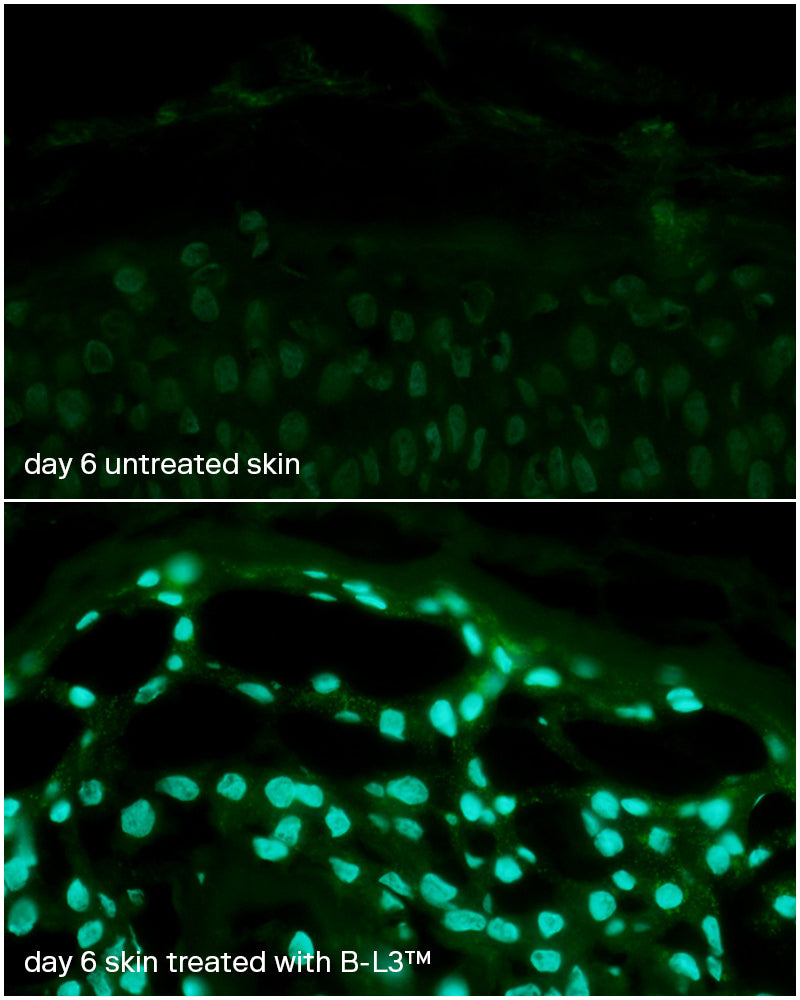The skin barrier acts as a protective barrier against external irritants, allergens, and microbes. When the skin barrier is compromised, it becomes more susceptible to damage and inflammation. A compromised barrier can result in increased skin sensitivity and irritation. In addition, a damaged barrier experiences increased transepidermal water loss (TEWL)¹, which can contribute to dryness and dehydration of the skin. Chronic inflammation and dehydration can accelerate the aging process², leading to the appearance of fine lines, wrinkles, and dullness in the skin. Therefore, maintaining a healthy and intact skin barrier is important for maintaining skin health and preventing premature signs of aging.
Because barrier damage is so common and present in so many skin issues, B-L3™ can be used in sensitive skin, aging skin, and may help protect the barrier even when the skin is healthy.
In a thorough genetic analysis, our third-party researchers used a model of human skin and investigated how the B-L3™ Complex influences the activity of 21,000 genes important for skin barrier structure and function. Traditional moisturizers sit on top of skin to treat skin’s surface and focus on temporary benefits like TEWL. Skinfix’s patented B-L3™ is proven to restore the structure, integrity, and function of the skin barrier.
After just one application, the bio-mimetic lipids works to reduce TEWL(transepidermal water loss) and boost skin’s hydration. Over time, B-L3™ is working on a deeper level** to increase ceramides, neutral lipids, filaggrin and other essential proteins to improve barrier health from within.
Protects Against Inflammaging and Promotes Barrier Repair and Regeneration
In the skin, oxidative stress can arise from various sources such as UV radiation, and pollution. Oxidative stress can leadto reactive oxygen species, which can damage important components of the skin, including lipids, proteins, and DNA. As a result, oxidative stress can directly impact skin barrier function⁴ leading to water loss and skin inflammation. The B-L3™ Complex is scientifically proven to affect the expression of genes associated with oxidative stress and commonly linked to inflammaging⁵, preventing the loss of moisture and lipids⁶, and supporting natural turnover of skin cells and tissue repair.⁷

Ceramides and neutral lipids are crucial for the skin's barrier function. Ceramides make up 50% of barrier lipids present in the skin and are essential for preventing water loss. Neutral lipids are needed to maintain the skin barrier’s integrity. In conditions such as eczema and psoriasis, neutral lipids are often deficient. B-L3™ was shown to improve skin barrier ceramide and lipid content following 1 day of application.⁸
Filaggrin proteins, synthesized within skin cells, play a vital role in the formation of the skin's natural moisturizing factor, which helps to retain moisture and maintain skin hydration levels. Aquaporin 3, a water channel protein located in cell membranes, facilitates the movement of water across skin cells, ensuring proper hydration. Together, these proteins work synergistically to uphold the skin's barrier function and promoting overall skin health and resilience. B-L3 is scientifically proven to improve natural moisturizing factor (NMF)⁹ and aquaporin 3 (AQP3)¹⁰ levels in the skin.

*Patent Pending
**in stratum corneum
Pająk J, Nowicka D, Szepietowski JC. Inflammaging and Immunosenescence as Part of Skin Aging-A Narrative Review. Int J Mol Sci. 2023 Apr 24;24(9):7784. doi: 10.3390/ijms24097784. PMID: 37175491; PMCID: PMC10178737.
³Joshi, R. et al. Free radical scavenging behavior of folic acid: evidence for possible antioxidant activity. Free Radical Biology and Medicine 30.12,1390-1399 (2001)
⁵ As shown in expression of biomarkers in an RNA microarray analysis ex vivo on reconstructed human skin models, decreases in genes that play a role in skin inflammation (SHROOM3, CX3CR1, ICAM1, EGR1, PDGFD). p<0.01
⁶ As shown in expression of biomarkers in an RNA microarray analysis ex vivo on reconstructed human skin models, increases in genes involved in the elongation of fatty acids (ELOVL1, ELOVL4), lipid metabolism, (LIPK, SULT2B1), cell volume regulation (LRRC8A), skin barrier integrity (GRHL1).
⁷ As shown in expression of biomarkers in an RNA microarray analysis ex vivo on reconstructed human skin models, increases growth factors involved in cell tissue repair (EGF and TGFB1).
⁸ Based on the results of a histology study using B-L3™ on living human skin explants ex vivo from a 54 year old woman, demonstrating increased barrier ceramide (upper) and lipid content (lower) in skin treated with B-L3 application, 1 day after application.
⁹ Based on the results of a histology study using B-L3™ on living human skin explants ex vivo from a 54 year old woman following, increase in filaggrin 1 day of use.
¹⁰ Based on the results of a histology study using B-L3™ on living human skin explants ex vivo from a 54 year old woman following 6 days of use.


